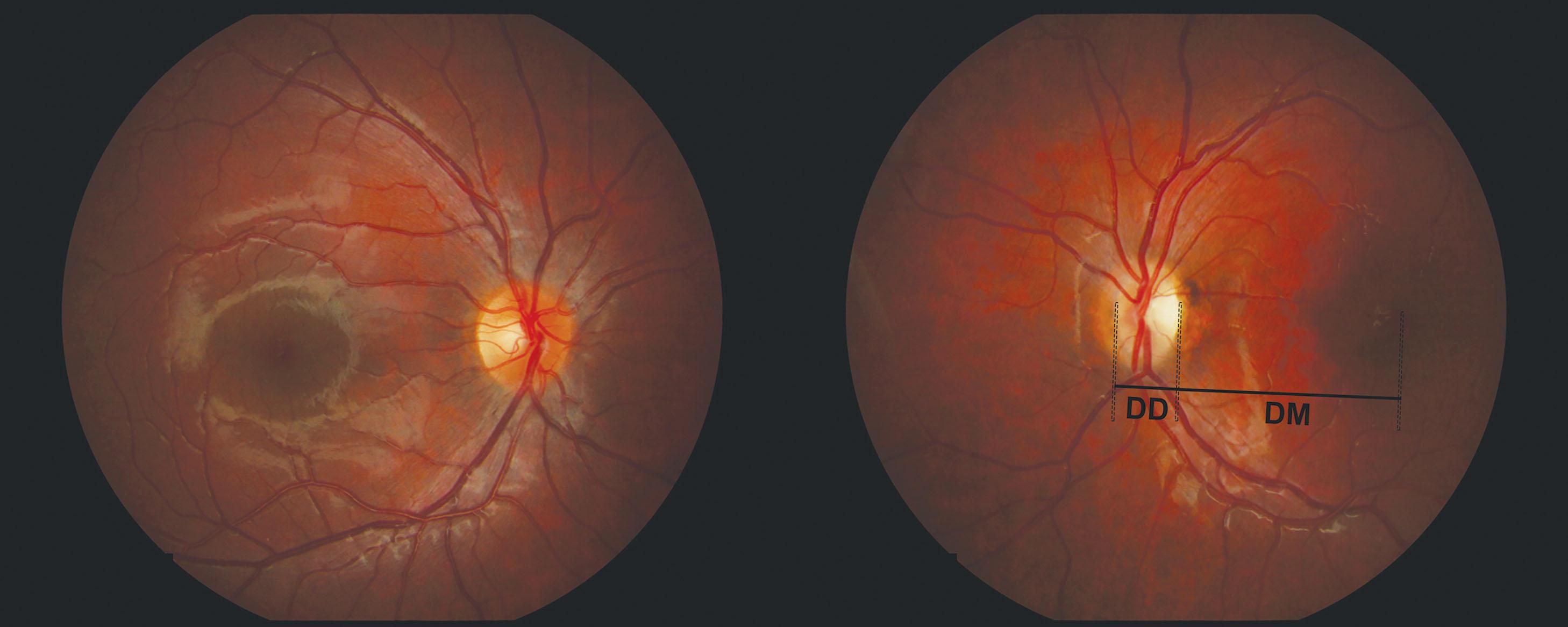Physical Address
304 North Cardinal St.
Dorchester Center, MA 02124
Congenital optic disc anomalies frequently present to the pediatric ophthalmologist. These disorders, when bilateral, are important in the differential diagnosis of infants who are referred for poor vision and nystagmus. Unilateral or less severely affected patients may be diagnosed later in life when sensory strabismus or other ocular complications develop. Systemic associations, particularly neuroanatomic defects and endocrine abnormalities, are frequent in certain congenital optic disc anomalies. Congenital optic disc anomalies may be grouped into those related to failure of retinal ganglion cell development or survival, excavated optic nerve anomalies, and other anomalies.
Optic nerve hypoplasia (ONH) is the most common congenital optic nerve anomaly and the leading ocular cause of visual impairment in children in high-income counries. The incidence of ONH in Northwest England was estimated to be 10.9 per 100,000 per year in 2006. In the United States, a population-based study in Olmsted County, Minnesota found that ONH affected 1 in 2287 live births over a 25-year period from 1984 to 2008. The incidence may be increasing; in Olmsted County, the incidence rate doubled in the last five years of the study compared to the first five years.
The optic nerve diameter in ONH is reduced, with an increase in the ratio of the disc–macula distance to the disc diameter (DM/DD). The 95% upper limit of normal is 2.94; therefore, a DM/DD ratio greater than 3 supports the diagnosis of ONH ( Fig. 53.1 ). However, a higher threshold may be necessary in infants, as De Silva et al. found that the DM/DD ratio in full-term and preterm infants without ONH averaged 3.76.

A characteristic sign of ONH is the “double ring sign,” in which the inner ring is the hypoplastic optic nerve head, and the outer ring is the scleral canal opening. The outer ring may be hyper- or hypopigmented. This sign is present in only 30% of eyes with ONH. Additionally, tortuous, or occasionally straight, retinal vessels have been reported in 20% of eyes with ONH. ONH may be challenging to diagnose in an uncooperative child, as the DM/DD ratio may be difficult to judge on a brief glimpse of the fundus, and the outer ring in the “double ring sign” may be mistaken for the borders of a normal-sized disc. Other helpful diagnostic signs include retinal nerve fiber layer dropout, decreased disc width-to-central retinal vessel width ratio (less than 2.5), pigment on the outer ring (which is consistent with scleral canal opening rather than optic disc rim), and the vascular anomalies described above.
ONH is bilateral in 75%–85% of cases, and visual acuity ranges from normal (with peripheral visual field defects) to no light perception. Studies have reported either no relationship or limited correlation between the size of the optic nerve and visual acuity, and central acuity depends on the degree to which macular axons are spared. Among bilaterally affected children, 80% are legally blind. Visual acuity may demonstrate marginal improvements over the first few years of life.
Ocular findings frequently associated with ONH include sensory nystagmus and strabismus, with esotropia predominating.
ONH is associated with hypothalamic dysfunction (particularly hypopituitarism), structural brain abnormalities, and adverse neurodevelopment. The literature has emphasized “septo-optic dysplasia,” also known by the eponym de Morsier syndrome, placing undue emphasis on the clinically insignificant finding of absence of the septum pellucidum. Clinicians must appreciate the full spectrum of systemic abnormalities that occur in children with ONH in order to perform appropriate surveillance and management.
In a prospective study, endocrinopathies occurred in 79% of children with ONH. The most common endocrine disorder is growth hormone deficiency. Others include hypothyroidism, adrenal insufficiency, and diabetes insipidus. Hypopituitarism may present with neonatal jaundice and/or recurrent hypoglycemia. Puberty may be delayed or precocious. Hyperprolactinemia occurs due to absence of dopamine from the hypothalamus, which suppresses prolactin secretion. Adrenal insufficiency may be compounded by thermoregulatory disruption and dehydration from diabetes insipidus during febrile illness, leading to sudden death in children with ONH. Non-endocrine hypothalamic disorders in children with ONH include temperature dysregulation, altered sleep/wake cycles, and abnormally increased or decreased thirst or hunger. Children with ONH may experience obesity or failure to thrive due to hyper- or hypophagia.
Absence of the septum pellucidum is seen in approximately 40%–50% of children with ONH, but is inconsequential to neurodevelopment. Other midline abnormalities include agenesis or hypoplasia of the corpus callosum and third ventricle dysplasia. Non-midline abnormalities are also frequent in children with ONH and include hydrocephalus, schizencephaly, colpocephaly, holoprosencephaly, pachygyria, cortical heterotopia, periventricular leukomalacia, and encephalomalacia.
Posterior pituitary ectopia occurs in approximately 15% of children with ONH. When present, this abnormality is highly predictive of endocrinopathy. However, hormonal deficiencies may occur in the presence of a normal appearing pituitary gland on neuroimaging. Therefore, all children with ONH should undergo endocrine work-up, regardless of neuroimaging findings.
Neurologic disorders are common in children with ONH. Margalith et al. reported cerebral palsy in 57%, mental retardation in 71%, and epilepsy in 37% of children in their series of 51 patients with ONH. Brodsky and Glasier found that neuroimaging abnormalities were predictive of neurologic impairment in children with ONH.
Developmental delays occur in 78% of children with bilateral ONH and 39% of children with unilateral ONH. Abnormalities of social communication and repetitive/restricted behavior, which are the two core symptoms of autism spectrum disorder (ASD), are common in ONH. Although nearly half manifest autistic symptoms, some young children with ONH experience improvement with age. It is unclear if this is related to the visual improvement that may also occur in this age group.
Become a Clinical Tree membership for Full access and enjoy Unlimited articles
If you are a member. Log in here